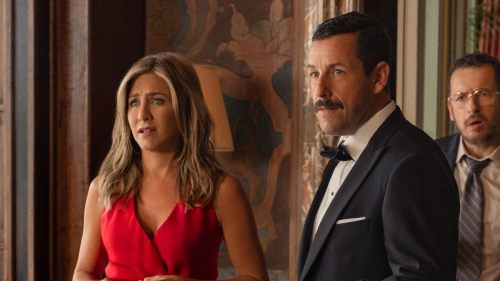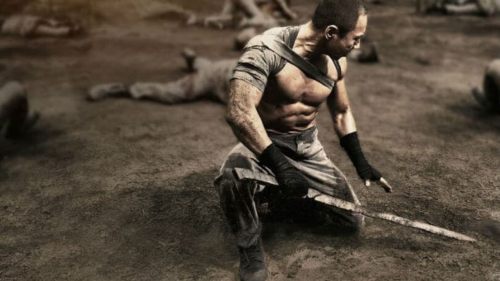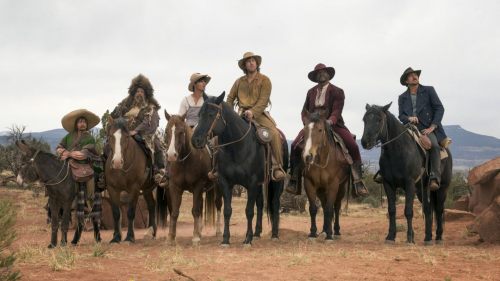THE BALLAD OF BUSTER SCRUGGS Review: Sketches Of The Old West
In various interviews, the Coen Brothers have stated the stories that make up The Ballad of Buster Scruggs – which began as a hazily defined partnership with Annapurna Television (though the Bros. swear it was always intended as a stand-alone movie) – date back to their days crafting odd, absurdist comedies such as The Hudsucker Proxy and Barton Fink. This makes sense, as the tonal variance between the vignettes runs a gamut similar to the legendary siblings’ seminal (and near flawless) body of work. In fact, if there's a direct comparison one could make while trying to sum up their Netflix anthology film, it'd be A Serious Man instead of True Grit. This is a sextet of Western folklore, attempting (in trademark Coen fashion) to make sense out of the senselessness of existence, often coming to the conclusion that these existential pontifications are errands for fools.
Unfortunately, these six campfire stories also distinctly feel like odds and ends that’ve been sitting in a drawer gathering dust. Much like their last proper feature, Hail Caesar!, the Coens are paying tribute to a bygone era. Only with Buster Scruggs they're making mini-movies that they hypothetically would've expanded into full-fledged stand-alone features, had they been alive during the so-called Golden Age of studio craftsmanship (or maverick New Hollywood that followed). The eponymous murder ballad that opens the movie (with Tim Blake Nelson warbling themes as the titular man of violence) feels fit for a '40s sound stage. James Franco fronts a Hawksian riff on an ill-fated bank robber (“Near Algodones”). Liam Neeson braves the bitter cold of anti-genre trappings equal to McCabe & Mrs. Miller (“Meal Ticket”). Tom Waits lends his trademark croaks to a CinemaScope-ready yarn regarding a lonely prospector (“All Gold Canyon”). Zoe Kazan possibly finds love on an Oregon Trail pulled out of a lost Ford film (“The Gal Who Got Rattled”). The ultimate entry (and only installment written specifically for this movie) emulates spooky, contained, hyper-talky Playhouse TV dramas (“The Mortal Remains”).
A book titled The Ballad of Buster Scruggs and Other Tales of the American Frontier (with color plates!) provides the picture with a tidy framing device, and nods toward the notion that the Coens have essentially fastened together shorts meant to be self-contained. Each time one of the tome's faded pages turns, "readers" are invited to recall that they're witnessing a retrospective on a genre, which we're digesting well after the date of publication (the late 1800s). Inasmuch, The Ballad of Buster Scruggs is as much a Coen Bros. Western about Westerns, and how that rather expansive format has evolved (or refused to) over time, at least within the realm of American cinema. Simultaneously, when you combine this repertory “binding” with the background that these stories’ conceptions span almost the entirety of the Coens' career, Buster Scruggs becomes a Coen Bros. Movie about Coen Bros. Movies as well.
Ultimately, this "all-encapsulating" approach is also what renders Buster Scruggs enormously frustrating. One would imagine that, were the Coens intending to write a filmic text analyzing their own artistic output, that they'd want it to resemble more than a collection of ostensible first drafts. While watching it, this author was often reminded of Stephen King's Skeleton Crew, a book that rescued one of the world's most famous horror author’s short stories (and even one of his best novellas in The Mist) from the pulpy pages of mens' magazines, gathering them into an easily digestible bit of bathroom reading (at least, that's where the collection resided in my house for years). The Coens are exploiting the Netflix binge format to get tales they were never able to previously tell out into the wild, offering them up within the construct of an anthology. The sad thing is: none of them feel like they were polished before publication, the rough edges possibly able to be rounded off with another editorial pass.
Essentially, Buster Scruggs finds two of our greatest cinematic artists making advances in distribution work for them, so it's tough to completely fault the Coens for spotting an opportunity and taking full advantage. However, operating with new technology isn't yielding the same beguiling textures as their previous pictures. The Ballad of Buster Scruggs is the Coens' first digitally shot feature, with Inside Llewyn Davis DP Bruno Delbonnel's lens producing a flatness that's never been present in the Bros' previous pictures. The duo can still frame a shot better than just about anyone, yet when projected on a big screen, it's tough not to notice the wonky SFX and lack of grain. Granted, it wouldn't make sense to shoot a movie on celluloid when the majority of your audience is going to ingest it from the comfort of their couches, eyes glued to flat-screen TVs*. Yet longtime fans are going to find something lacking, even in the most beautifully composed vistas.
The bright spots contained in Buster Scruggs shine like pieces of gold in Waits' prospector dish. Nelson's hyper-violent wrath is like a shot in the arm, announcing the movie's arrival in a way that the rest doesn't quite follow up on. Ditto Franco's bombastic stick 'em up story, which features another great little turn from Stephen Root (who was a similar scene-stealer in No Country For Old Men). Kazan's widow on a wagon train provides the movie some much needed pathos, as the cowboy (Bill Heck) who becomes smitten with the lost lady stumbles to find the right words regarding how to propose they spend a possible future together in the Pacific Northwest. A shoot out with a native war party in that same segment is incredibly suspenseful, reminding you that the Coens are quite capable at staging action when called upon to do so.
None of the sections are predictable (in fact, a few out-and-out subvert our expectations) outside of the fact that, in all of them, somebody (or many bodies) die horribly. All of the sections contain some sort of musical element (supervised by usual Coen songsmith Carter Burwell) and never seem like they're straining to include the melodies, as if casually trying to hold true to the picture's title. After all, ballads are often nothing more than morality tales, set to music and handed down through the generations. There's also a mythic component injected into every chapter, as the Coens' are tuned in to the notion that all legends grow out of something that was once true, but became distorted into a bigger than life cautionary parable over time.
Strangely, for all their obvious talents, the Coens still can't avoid the usual anthology film pitfalls of including too many stories while failing to nail the perfect sequential pacing. After the high energy of the first two stories, The Ballad of Buster Scruggs takes a tonal dip that the movie never quite recovers from. The third segment is downright pensive, before Waits' wading into the river becomes slightly repetitive, and then the wagon train makes the viewer actually feel like they’re headed to Oregon via horse-drawn carriage. This all leads to the final story, which is set inside a stagecoach, with all of the actors seated and yammering on at one another. It's the cinematic equivalent of frontloading your B-Sides record with two discarded singles, only to noodle on with experimental tracks for the rest of the album. Frankly, it’s a baffling narrative decision.
None of this is to say that the Coens have strayed from their usual messaging regarding life's cruelty and futility, especially when talking about existence's certainties (or lack thereof). Like Quentin Tarantino, the Coens have always been able to mix graphic violence and black humor for seismic results (the wood chipper from Fargo instantly comes to mind), and their later years saw them growing more and more existential, but no less hilarious (No Country). However wonky, the sequencing of these stories reflects both a pervading air of portentousness, as well as the evolution of their central theme's delivery. Nelson's massacre-addicted troubadour seems like he jumped from the brain of Barton Fink. The dark clownery of Franco's heist man would sit nicely next to O Brother’s bumbling criminals. The Man Who Wasn’t There’s stark fatalism guides the path of Neeson and his legless, armless sideshow orator. Tom Waits' river sifter is looking for the same “get rich quick” easy answers as the gym rats of Burn After Reading. Kazan's wagon train love affair wouldn't feel out of place in True Grit's throwback universe. The yappy otherworldliness of the final story recalls A Serious Man's cryptic bookends.
There's always been a spiritual side to the Coens' movies, especially post-No Country (which is a neo Western in its own right). Their fictions seem to try and discover order in a chaotic universe, perpetually reaching for meaning, only to grab a fistful of dust. Even when the Brothers explored their own creative process onscreen – writing Barton Fink during the making of Miller's Crossing as a means of exorcising certain artistic demons – it resembles two geniuses crawling out of an inescapable flaming pit with their souls intact. Perhaps transmuting this driving, elemental ethos into a literal (projected) text only heightens how their latest comes up short when compared to their fully developed previous chapters. We already knew what sort of endgame (or, again, lack thereof) the Coens are after, and receiving asides taped together into a scrapbook emphasizes their incomplete nature when held up in comparison. These are notes passing themselves off as sermons, lacking the fire and brimstone of these prophets' more inspired lessons from a life that offers none.
*Though this obviously didn’t stop Alfonso Cuarón from shooting Roma in gorgeous B&W 65mm, despite it debuting on Netflix.
The Ballad of Buster Scruggs opens in select theaters and on Netflix November 16th.



